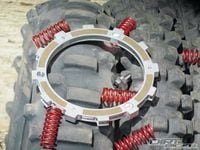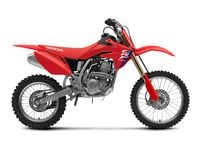The auto-clutch is here to stay and is past that phase where it is some sort of gimmick. Heck, we've picked it, in different evolutions, as Product Of The Year a couple of times now. There are two ways to look at it; either you love it or you won't give it a chance. At least that's what I say. Like anything, there are advantages and some disadvantages, but Rekluse has taken one of the biggest issues and made it go away.The new EXP is basically a drop-in part, no longer requiring a basket or pressure plate change and no more tuning with hard-to-distinguish ball bearings or needing special tools. The EXP simply drops into the stock basket after you remove a few of the standard plates and fit it in the void. Depending on the bike, you replace the clutch actuation bearing or have to install some spacers. The instructions are easy to follow, complete and tuning the clutch is done with simple springs that are installed with quarter-turn fasteners (and the cable tension on non-hydraulic clutch bikes). There is even more advanced tuning with different weight wedges, but these are left to very specific riders with unique needs as Rekluse does a good job of supplying a standard setup that most riders will like.
By remaining contracted at low rpm, the EXP leaves the clutch pack loose and disengaged until the clutch begins spinning fast enough to get the wedges to push outward and expand the EXP. Then the clutch starts to grip as if you were letting the clutch lever out, yet it self-regulates so the bike has a very difficult time stalling. Why? Well, if the rpm tries to drop to a point of stalling, the clutch frees up and no load is left on the engine, so it keeps running. The other plus with the EXP, for the most part (any time you are at a riding rpm), is the clutch lever feels just like normal and you can still use it to control power. But after time you will find that redundant--the throttle is a better regulator of power. Basically, even your fire-breathing motocross bike can be as easy to ride as a Honda CRF50F. And with the EXP you can still slip the clutch to control power, snap it to get a big hit, and use it just like normal on the start line without any funny or inconsistent lever feeling.What are the disadvantages? Well, full-throttle power shifts can be difficult on some bikes, requiring the throttle to be backed off just a bit; typically the better a bike shifts with a regular clutch, the better it will do with the Rekluse. Also, if you tend to brake hard enough to lock the rear wheel, the bike will act like it's in neutral when you get off the brakes. Some riders like this (no compression braking at all!) and some don't. Tuning the springs in the clutch to lower the engagement rpm makes this happen a lot less. Overall clutch wear, as long as you ride in the correct gear, isn't any worse and, in fact, is usually better than standard. Oddly enough, sprocket and chain wear is accelerated.Especially for off-road and even for motocross most of the time, I am a convert. Yes, I will say an auto-clutch is not for everyone, but I feel most riders would benefit from one since clutching and stalling is one more thing that they can forget about when riding. And installing one is now as simple as riding with one. Available for most of the popular 250cc to 450cc Japanese bikes as well as a variety of KTM and Husabergs from 250cc on up for a cost of $399.
www.rekluse.com
866.735.5873

/cloudfront-us-east-1.images.arcpublishing.com/octane/FYDGK7GF4JBPXERA5RAZPY3YJI.jpg)
/cloudfront-us-east-1.images.arcpublishing.com/octane/JE7KMNASNRGR7FLYAFRZAR7T7E.jpg)
/cloudfront-us-east-1.images.arcpublishing.com/octane/7RCNKJJNXBF4LBKZXE2INNWZUY.jpg)
/cloudfront-us-east-1.images.arcpublishing.com/octane/BAGM5E4EWBHFNLZOXMSLOLKQGU.jpg)
/cloudfront-us-east-1.images.arcpublishing.com/octane/RSX65VBXY5FRLIY4LN6WLOKAFM.jpg)
/cloudfront-us-east-1.images.arcpublishing.com/octane/3EO2CNKWUFBGNMGNJPETW5HCNY.jpg)
/cloudfront-us-east-1.images.arcpublishing.com/octane/IYHM55XRNVHF3DSS3467PZ7ONQ.jpg)
/cloudfront-us-east-1.images.arcpublishing.com/octane/L7K3FIINEBHMZI2TXTUE4FXH7I.jpg)
/cloudfront-us-east-1.images.arcpublishing.com/octane/XE7P5YXNZZDUTIGW4YNWQRDVY4.jpg)
/cloudfront-us-east-1.images.arcpublishing.com/octane/AV55DOHQ3BEXJLPWR6UWLYUSAQ.jpg)
/cloudfront-us-east-1.images.arcpublishing.com/octane/MMROGOYHXZAYDC4RKIDJ4VRSGA.jpg)
/cloudfront-us-east-1.images.arcpublishing.com/octane/FHRWLPEOTBFOHFTQLIHJNIXCFQ.jpg)
/cloudfront-us-east-1.images.arcpublishing.com/octane/J2RUDOXTOZHBXOFCUQKBAGBMAQ.jpg)
/cloudfront-us-east-1.images.arcpublishing.com/octane/UDQASRGJ3ZDG3BANXWU6P5NIQY.jpg)
/cloudfront-us-east-1.images.arcpublishing.com/octane/YIICVWCT7FDURLJQ2H4AIMXLOY.jpg)
/cloudfront-us-east-1.images.arcpublishing.com/octane/SKYGGQY3XJCPDAM4CUHUXBS444.jpg)
/cloudfront-us-east-1.images.arcpublishing.com/octane/AONOEIBHJBGMBOCD5HBWVB3UAI.jpg)
/cloudfront-us-east-1.images.arcpublishing.com/octane/76O4I66VBNBS5GXX4DNHXXKHR4.jpg)
/cloudfront-us-east-1.images.arcpublishing.com/octane/3LSXOLSH3NEJDBMO3JZ6CYMK5M.jpg)

/cloudfront-us-east-1.images.arcpublishing.com/octane/QNIQ2A4UEBGNRKB4STEBJPMUX4.jpg)
/cloudfront-us-east-1.images.arcpublishing.com/octane/35SLCX4NQ5AFTHU6EY7FJSNGEY.jpg)
/cloudfront-us-east-1.images.arcpublishing.com/octane/LVH6MQASTRA2RJ74WY2PM7OAFI.jpg)
/cloudfront-us-east-1.images.arcpublishing.com/octane/TDBZ2JZJ7ZBNBLMB677WNPFLJE.jpg)